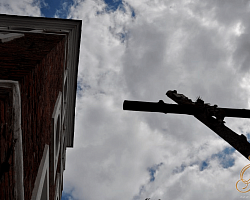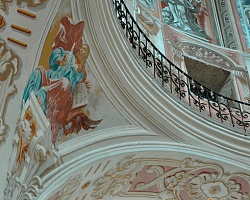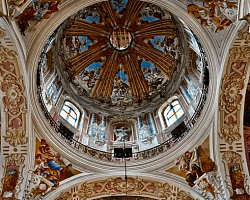Monastic orders
Niasvizh Catholic Corpus Christi church
Niasvizh Catholic Corpus Christi church was built in 1587–1593 according to the design of the Italian architect Giovanni Maria Bernardoni at sponsorship of Mikołaj Krzysztof «the Orphan» Radziwiłł. The Jesuit church in Niasvizh was the first construction in Baroque in the whole territory of Rzecz Pospolita.
The temple interior is richly decorated with paintings. The frescoes were performed in 1750–1760-s with participation of the artist Ksawery Dominik Heski (restored in 1900–1902). The frescoes embrace 40 individual compositions depicting Saints, allegorical scenes and biblical stories. The fresco compositions include cartouches with the Bible stanze and references. There is K.D. Gesski’s picture «The Lord’s Supper» (1753) in the main shrine. In addition to the paintings, the church interior contains a lot of plastic images, i.e. bás-reliefs and bust gravestones of the 17th — 19th centuries, marble altars and monuments. There is a choir with an organ above the temple entrance. An entrance into the family crypt — a burial vault of the Radziwills — is located next to the bás-relief under the altar of Christ. There are over seventy burials of the mighty dynasty in the semi-basement.
A complex of the former Benedictine cloister
The complex of the former monastery for Benedictine nuns is located in the southern part of the town. It was founded in 1590–1595. It was the first monastery for Catholic nuns in Belarus. Alongside with the monasteries for Jesuits and Bernardines, it was part of the town defense system. The founder of the monastery was Euphemia, the wife of the first Ordinate of Niasvizh Mikołaj Krzysztof «the Orphan» Radziwiłł. The monastery was constructed in ensemble with St. Euphemia’s church.
In 1866, the Catholic church was reconstructed into an Orthodox church, the monastery was closed and, in 1876, it was turned into a military barrack. From 1920 to 1945, the monastery resumed its activities. After the Great Patriotic War, a teachers training school settled down in the monastery complex. At present, the hostel of Niasvizh college is located there.
A complex of the former friars minor order cloister
The St. Katherine church and the cloister complex were built in 1598 on the project of Italian architect Giovanni Maria Bernardoni. In XVII century chapels of St. Francis and St. Anna were added to the church. The school of theology opened there in 1628, in 1654 it was reorganized to philosophy school. In 1655, by the fire, the cloister was destroyed and then rebuilt in 1662. There were located a gravestones of patrons from different magnate and gentry families. For example, there located a grave of Michał Kazimierz Rejtan — an ancestor of well-known Rzecz Pospolita figure Tadeusz Rejtan. The crucifix that was located there was known as miraculous.
In 1864 the cloister was abolished, the residential building handed over the military department and the church was rebuilt as orthodox church. The cloister was damaged during the WWII, church was destroyed in 1950th. One of the monastery hulls saved till nowadays.
A complex of the former Dominicans cloister
It was found in 1672 by Bazyli Bakanowski and Mikołaj Krzysztof «the Orphan» Radziwiłł. In 1680 was built a new church in honor of John the Baptist. Its walls and vaults were painted by the son of Ksawery Dominik Heski — Josef. The cloister was abolished in 1877 and there was found a Teachers Seminary. A. Bagdanovič, J. Kolas, K. Čorny were graduated from there in different times. The church of St. John the Baptist is not preserved. Its building was destroyed in post WWII times.
















